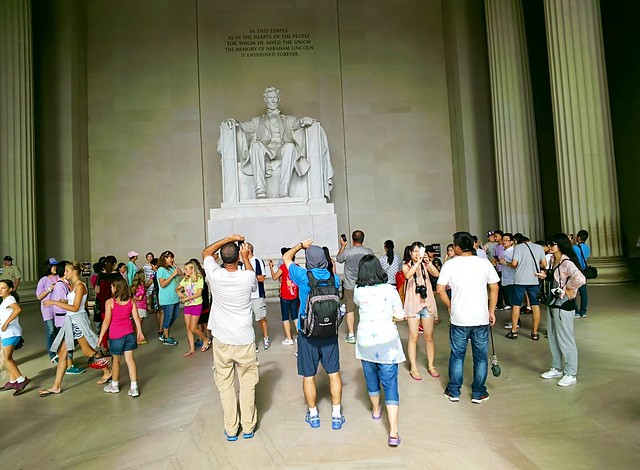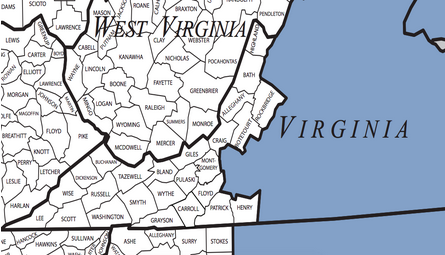When discussing Appalachia or where I’m from, I often hear remarks from East Coasters, mostly Washington DC-based folks, about visiting Shenandoah National Park or taking even doing winery tours in the mountains. They relay the positive tourism experiences they’ve had in Appalachia, mostly in Virginia. Often, I appreciate these rose-colored views. They seem better than the poverty or hillbilly bit most of us are used to hearing.
When diving deeper into the economics of tourism in the region, though, I find a major disconnect: For Virginia’s Appalachian counties, few tourists visit when compared to other counties in the state and the Central Appalachia region.

In 2017, the state of Virginia raked in $25 billion in revenue. Washington DC tourism dominates the overall state tourism numbers. In 2017, the capital city attracted 22.8 million visitors who spent over $2.8 billion. Northern Virginia, home to Arlington Cemetery and other national monuments, benefits greatly from this market while many visit, stay in, or spend their money in the area. in The northern counties of Fairfax and Arlington bring in the most tourism money out of anywhere in Virginia.
After DC, Virginia Beach is the second-largest attraction in the state, though a tragic and recent shooting could affect the tourist numbers. In Las Vegas, the months after the 2017 shooting were sluggish. Virginia Governor Ralph Northam is calling for quick-response legislation for more gun regulation, but it may not be enough to bring in tourists.

Then comes the Virginian wine country that southern Virginia is famous. Many wineries and vineyard getaways boast of mountain escapes and Blue Ridge beauties with fields of rolling grapes. However, on the “Virginia is for Lovers” tourism website, all of the listed wine tours are east of the Appalachian region, which leaves these stops outside Appalachian Virginia’s tourist economy.

Many Americans reference the Shenandoah National Park as an Appalachian beauty, so it may surprise them that the park falls outside the Appalachian Regional Commission’s denoted borders. This is problematic for how we calculate tourism in the region: The lines drawn for the region don’t always match up with the national consciousness.
The case for Virginia’s Shenandoah as part of Appalachia is strong. It lies squarely in the Appalachia mountain range and 105 miles of the Appalachian Trail runs through the park. It is a common destination for city folk of the East Coast, especially Washington DC residents, who want a bit of air and nature only an hour from DC.
Leaving Shenandoah outside Appalachia begs the question: Why did ARC draw the map the way it did? The federal government’s definition of Appalachia was created in the 1960s, starting with President Kennedy then culminating with the formation of ARC by President Johnson. This map of Appalachia, and the counties contained therein, demonstrated where the economic development was most needed in the region. This could explain why the Shenandoah area was left out of the map; it was already a bustling destination for Americans without the need for ARC development funds.
Without calculating Shenandoah tourist revenue, Appalachian Virginia does not stack up against neighboring Appalachian states that are home to iconic tourist destinations. Tennessee has the Great Smoky Mountains—the most-visited National Park with over 11 million annual visitors. West Virginia has the New River Gorge, where tourists annually spend around $56.2 million. In North Carolina’s Buncombe County, home to Asheville, Pisgah National Forest, and other popular destinations, visitors spend as much as $1.9 billion supporting local businesses.
Though meager in dollars spent, Appalachian Virginia is home to two important trails: The Appalachian Trail and the Creeper Trail. To reach them, many hikers and tourists head to Abingdon or Damascus, two towns whose economies rely heavily on tourism. The Appalachian Trail goes from Georgia all the way to Maine. Most people hike the trail in sections, although some hike the entirety in one trek which lasts six or seven months. Every May, Appalachian Trail Days brings an estimated 25,000 visitors into Damascus.
The Creeper Trail, a renowned 34.3 million rail and recreation trail, sits squarely in Washington County (near the Tennessee and North Carolina borders) and passes one of the highest peaks in Virginia. It goes through Abingdon and Damascus, at one point converging with the Appalachian Trail. The Creeper Trail is relatively new, established as a national recreation area by Congress in 1989, and a community-driven project with federal help from the US Forest Service. The project was planned to turn an abandoned timber railway into a destination spot for nature lovers and now brings in over 250,000 visitors each year and an estimated economic impact of $1.59 million. It could provide a model for other parts of Virginia trying to create other tourism destinations.
Studies often demonstrate the ways trails economically benefit surrounding communities. The Pennsylvania Land Trust Association compiled results from the study of economic effects of trails across the U.S. and found that trails have many community benefits such as low- or no-cost recreation to local residents and encourage healthy behaviors such as exercise and exposure to nature. Trails can also increase property values and attract homebuyers. Trails often spark entrepreneurial ideas such as shuttle companies, restaurants, and equipment rentals.
Furthermore, ecotourism is an avenue of tourism that many seem to think a smart investment these days. According to the International Ecotourism Society, ecotourism consists of “responsible travel to natural areas that conserves the environment, sustains the well-being of the local people, and involves interpretation and education”. It’s a trendy word often used for luring environmentally conscious travelers to different parks and businesses. Friends of Southwest Virginia expect a 56 percent increase in tourism over the next decade. ARC has begun investing in ecotourism projects throughout the region. They also support different forms of tourism development through educational conferences and grants to regional non-profits and universities.
Still, Appalachian Virginia’s tourist market remains elusive as domestic and international visitors usually head to coastal beaches, national parks, and historic monuments. However, the region isn’t without hope or means of creating a bit of rural heaven. The area is an under-developed market that entrepreneurs, communities, and federal programs, like ARC and the US Forest Service, could home in on. Appalachian Virginia should look to its regional neighbors and to its very own Creeper Trail to learn how to invest and grow its outdoor tourism market.
Subscribe to The Patch, our newsletter, to stay up-to-date with new expatalachians articles and news from around Appalachia.
Alena Klimas is a writer and cofounder of expatalachians. Klimas is passionate about economic and community development in Appalachia. Now, she lives and works abroad in rural community development. To learn more about the expatalachians team, click here.

